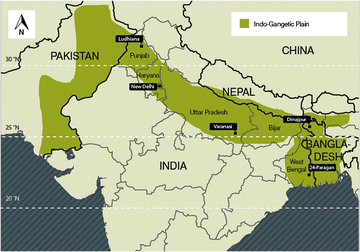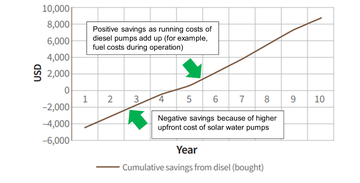Case for Solar Water Pumps
“Alright, Lalima, let’s hear from you about some examples of where climate change has impacted water resources and affected the business environment of the region.”

“Sure..., I don’t know where to start with this.”

“Okay, let me explain climate change has a huge impact on South Asia's water resources. Changing monsoon patterns have increased variability, droughts, and heavy rainfall events, reducing water availability and agricultural production. The melting of Himalayan glaciers has lowered river flows, threatening water supplies, hydropower generation, and agriculture. Rising sea levels have allowed saltwater to penetrate the region's wide coastline, polluting freshwater supplies. Floods and other water-related disasters have become more often and severe, destroying infrastructure and displacing people. Groundwater depletion, exacerbated by climate change, has resulted in widespread water scarcity. Water pollution and sanitation issues have gotten worse as a result of climate change-related disasters. To promote resilience in this sensitive region, addressing these concerns requires integrated water management, sustainable practices, and international cooperation. Now, I think you can share one example.”

“Ummm….let me share one. My father runs a diesel pump supply business and is branching out services on the construction of irrigation systems, so maybe an example around the use of diesel pumps would be appropriate.
Firstly, we need to spread awareness about the negative impacts that fossil fuels have on the climate and more importantly, make users understand the climate risks that may fall onto them. The greenhouse gases emitted from diesel pumps, in this case, contribute to global warming, which exasperates all the climate-induced risks we have shared and talked about. These risks again negatively affect various sectors of the economy and MSMEs that support it.
From a business perspective, businesses like my father’s continue to supply diesel pumps because there is demand for it. Only when users consider the long-term financial and environmental benefits, they will understand the argument against it and opt for cleaner technologies for water pumping. But as long as awareness is low, the demand for diesel pumps will exist and businesses like my father's will continue to supply it. This is where I want to change the narrative. I want to make the move away from diesel pumps and take a conscious effort to spread awareness of solar water pumps through clever marketing while still fulfilling the customer’s aspirations. This, I believe, will grow my father’s business and contribute to a sustainable future.
I think we all present here, and most of the youths who are generally aware of climate change want to see the transition from fossil fuel use (for example, diesel fuels) to renewable energy (for example, solar energy, wind energy). However, diesel-fueled pumps are still popular. Across the Indo-Gangetic Plains, an estimated 10 million diesel pumps are estimated to be in operation in 2019, with a majority of pumps being operated in India, Pakistan, Bangladesh, and Nepal (Adhikari, Mahapatra, Sapkota, & Puppala, 2019).
In much of the developing world, diesel-powered pumps are used rather than those powered by electricity, because of the poor supply of electricity and load-shedding issues (Adhikari, Mahapatra, Sapkota, & Puppala, 2019).”

Aabroo expressed her curiosity.
“What are the Indo-Gangetic plains?”

“It’s the region where…. wait, I’ll show you the map.”

Lalima took out her smartphone and opened a map of the Indo-Gangetic plains.

Image source: (Soneja, Tielsch, Khatry, & Breysse, 2016)
As Aabroo looked at the map, Lalima continued explaining.
“Also, in Lalalistan, diesel pumps are quite popular. When I discuss the negative effects of diesel pumps with my father and that he must start transitioning to offer renewable energy solutions, he brings up some valid points from the perspective of the users. He says,
- It is very important to understand the user’s perspective. Say, for example, a farmer in the flat plains of Nepal (known as the Terai region) wants a water pump to irrigate his or her piece of land. Now say, they are faced with two options. One would be to buy a diesel pump and the other to purchase a solar water pumping system assuming there is no access to electricity and other pumping solutions. Now, farmers in South Asia are also known to have moderate to low financial literacy (Das & Maji, 2023). When the farmer asks for the price of the two pumping options, the upfront cost of a solar water pumping system will be higher than that of diesel pumps. Given this choice and the status of their financial literacy, would the farmer make a conscious choice to purchase a solar water pumping system for its climate benefits? From what he has seen in the field and after running the business for 25 years, farmers usually make financial decisions based on the upfront cost, in which case, they will choose diesel pumps because it is cheaper.
- We might know that although solar water pumps may be perceived as expensive because of their relatively high upfront cost, their cost of operation and maintenance can be lower than that of diesel pumps – for example, because it doesn’t require fuel to operate once installed. So, over a certain number of years, diesel pumps can prove to be more expensive than solar water pumps. A handbook on solar water pumps shows an example of a lifecycle cost analysis and came up with this graph.


Figure 2 Payback of solar water pumps vs. diesel pumps
Image source: (Gautam & Malla, 2023)
From the graph, we see that the investment in solar water pumps can be higher in the beginning, hence, the negative savings; but, in this case, in four years, solar water pumps can have positive savings because of the high running cost of diesel pumps. Keep in mind, savings also means earnings. We should explain this to farmers and spread awareness.
So, unless the users understand the long-term financial and environmental benefits, we will be faced with the challenge of transitioning to renewable energy sources. This requires efforts in widespread education and awareness.”

"No, that’s quite true. We need to look at problems from the user’s level.”

Average Rating: ☆ ☆ ☆ ☆ ☆ (0 reviews)

